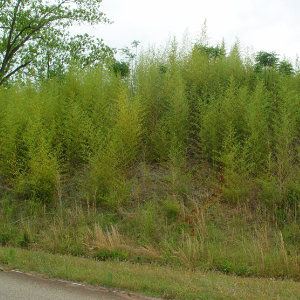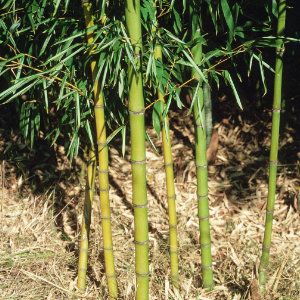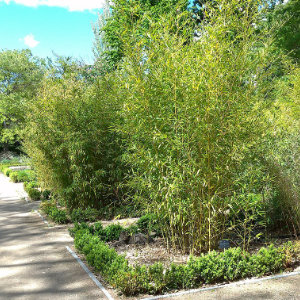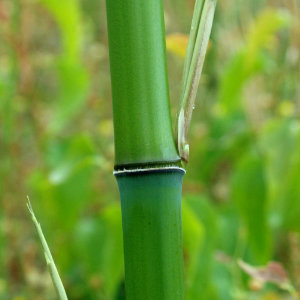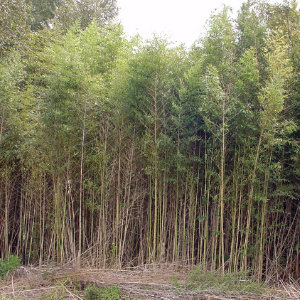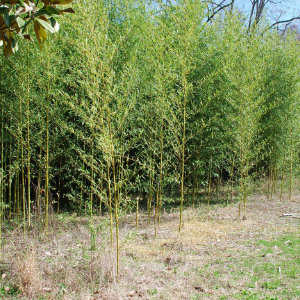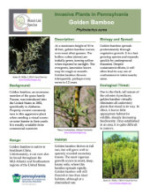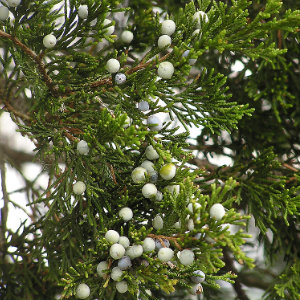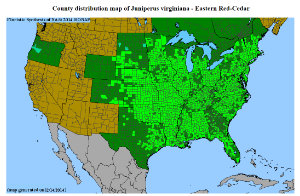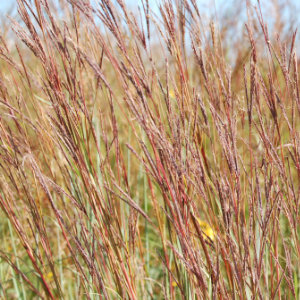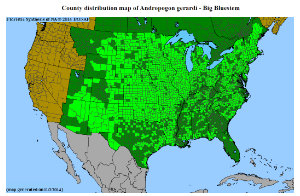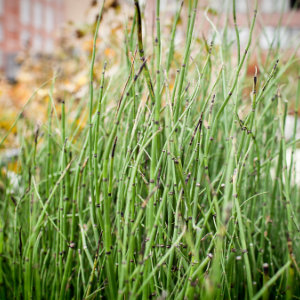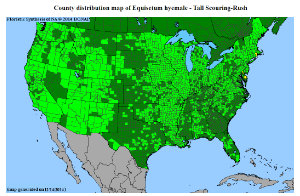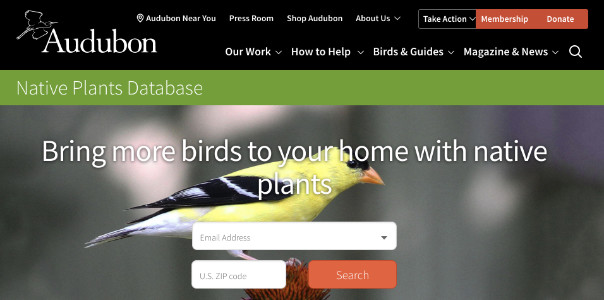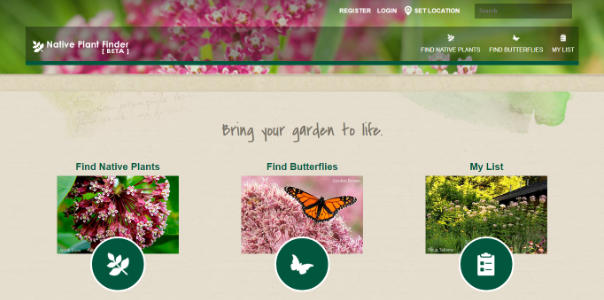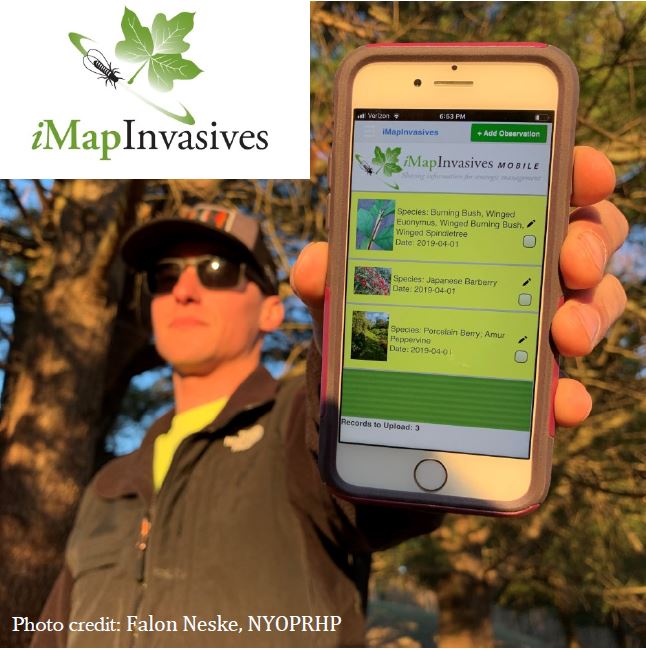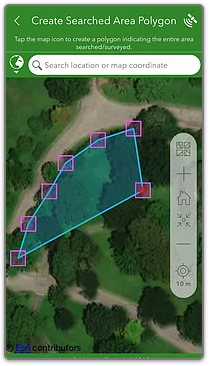Golden Bamboo
Golden bamboo (Phyllostachys aurea) is popular for many home gardeners wanting to plant a natural privacy screen, or to add height to their garden plantings. However, this non-native invasive grass is capable of escaping from residential areas and into natural spaces where it forms dense monocultures, competing with native plants. Food resources and habitats for wildlife are degraded by invading bamboo.
- Credit: Chuck Bargeron, University of Georgia, Bugwood.org
- Credit: James R. Allison, Georgia Department of Natural Resources, Bugwood.org
- Credit: Laura Hale, CC BY-SA 3.0, via Wikimedia Commons
Identification
Golden bamboo is part of the grass family and is considered an evergreen perennial flowering plant. It can grow to a height of 30-40 feet and forms very dense thickets sometimes referred to as “bamboo forests”. The stems of golden bamboo are hollow and jointed. Young stems are green in color and become golden-yellow as they age and are exposed to sunlight. Its leaves grow to be 6” long and are slender, lance-shaped, and often arranged in fan-like clusters.
Golden bamboo may be confused with other species of bamboo, but can be distinguished by looking at the internodes, or the part of the stem between two joints. This area will appear short and swollen at the base of the stem on golden bamboo.
Additional information on how to identify golden bamboo can be found online.
Ecological Threat
Golden bamboo will invade both natural and human-dominated areas. The thick, tall monocultures it outcompetes native vegetation for space and light Leaf litter from golden bamboo found along streams impacts litter-feeding invertebrates, leading to altered ecosystems and stream food webs. Golden bamboo provides little to no valuable habitat for wildlife.
Control and Removal
If golden bamboo is present on your property, consider removal and management options. The following resources provide valuable information and tips.
Other management tips can be found at:
Plant Native Alternatives
*This list is not comprehensive, but rather provides a sampling of species available for purchase from retailers located in Pennsylvania and/or surrounding states. All native plant distribution maps (below) are provided by the Biota of North America Program.
- Credit: lcm1863, “7383 Eastern Red Cedar Tree, Gettysburg”, CC BY-ND 2.0
Eastern Red Cedar (Juniperus virginiana)
Eastern red cedar can easily be grown in average, dry to moist, well-drained soils and prefers to be in areas that receive full sun. Though it prefers moist soils, it is intolerant of constantly wet soils. Eastern red cedar will grow to a height of 30-65 feet and has the best drought resistance of any conifer native to the eastern United States.
- Credit: Friends of the Prairie Learning Center and Neal Smith NWR, “Big Bluestem”, CC BY 2.0
Big Bluestem (Andropogon gerardii)
Big bluestem is an ornamental grass capable of growing 4-6 feet in height and in average, dry to medium, well-drained soils. It prefers areas that receive full sun. Once established, big bluestem is easy to maintain and has excellent drought tolerance.
- Credit: Josiah Lau Photography, “Equisetum hyemale”, CC BY-ND 2.0
Horsetail (Equisetum hyemale)
Horsetail can be planted in medium to wet soils and is tolerant of many soil conditions, capable of growing even in 4” of standing water. Horsetail prefers areas that receive full sun to part shade and can grow to a height of 3-5 feet. Consider using this plant in a water garden.
Learn More and Take Action
Why are Native Plants Important?
Learn more about the importance of planting native plants by reviewing the following resources. And remember, planting even one native plant on your property is a tremendous benefit to wildlife and the environment!
Doug Tallamy Explains, “Why Native Plants?”
Credit: Catherine Zimmerman
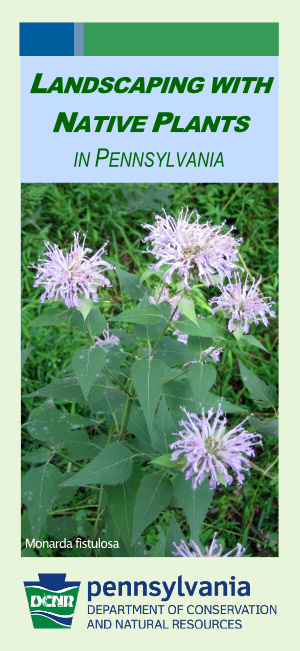
Landscaping with Native Plants in Pennsylvania
Credit: PA Department of Conservation and Natural Resources
Professor Doug Tallamy on Sustainable Landscaping
Credit: University of Delaware
Discover Native Plants.
Learn what plants are native to your area by using the National Wildlife Federation’s Native Plant Finder or the Audubon’s Native Plants Database. Both programs are easy to use - just type in your zip code and a list of native plants is provided to you.
Record Invasive Species Findings with iMapInvasives.
If you find invasive plants and animals in natural areas such as parks, forests, and meadows, please report them to iMapInvasives, an online tool used by natural resource professionals and citizen scientists to record locations of invasive species The iMapInvasives program is useful in understanding species distributions statewide and is used by land managers to prioritize locations to conduct treatment efforts. In Pennsylvania, the iMapInvasives program is administered by the Western Pennsylvania Conservancy and the Pennsylvania Natural Heritage Program and is financially supported by the Great Lakes Restoration Initiative. At the national level, iMapInvasives is administered by NatureServe.
A free registered user account is needed in order to contribute and view data in iMapInvasives. Register here.
How to create a presence record in iMapInvasives online (video)
Connect with Our Experts
Please direct any questions or comments regarding this species profile to Amy Jewitt, Invasive Species Coordinator, or Mary Walsh, Aquatic Zoology Coordinator.

